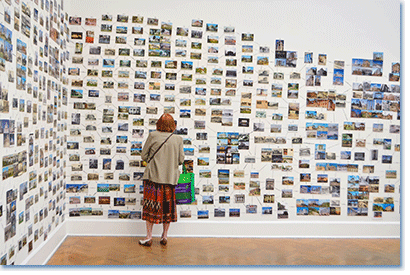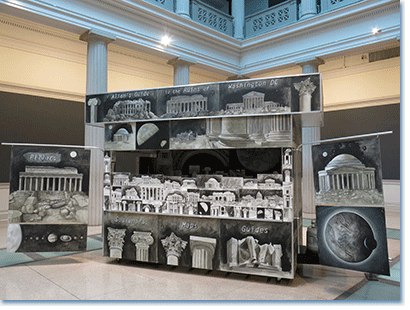Tourist season is winding down, but you’re in town and you decide to see what’s left of the big shows at the museums before they close for the fall installations. Since you are a historian, you’re pretty comfortable in this territory—venerable buildings in which you can view exhibitions with strong scholarly content and well-supported points of view. You know to read the wall text—all of it—and to grab the guide on the way in. So when the large black, white, and gray kiosk confronts you in the gallery’s atrium emblazoned with the words “Souvenirs,” “Maps,” “Guides,” and “Mystery Revealed,” you assume you’re looking at contemporary art skewering tourists. Not, in other words, you. But it turns out, you, historian, are in fact the subject of Ellen Harvey’s smart, interesting, funny show at the Corcoran Gallery of Art, The Alien’s Guide to the Ruins of Washington, DC.
A closer look at tourist kiosk (“Alien Souvenir Stand”) reveals that it is covered with chiaroscuro images of classical capitals and colonnades, and many of the quickly recognizable monuments of Washington, DC (the Jefferson and Lincoln memorials jump out) are depicted amid rubble and fragment. Closer still, you can see that rubble is reminiscent of bomb damage rather than decay or disrepair. What has happened here? Some will recognize a reference to the Parthenon, which lost its 5th century BC roof in a 19th-century explosion, in the blown-out roofs and broken pediments depicted. A large panel that says “Pillars” hangs on the kiosk side—why, thinks the viewer, would anyone sell pictures of pillars? And who calls them “pillars,” anyway?
In another room, a single aluminium sculpture (“Alien Rocket Ship: The Latest in Pillar-Builder Space Travel”) combines an obelisk and Corinthian column to make a rocket ship, but without any of postmodernism’s irony or smirking. Situated almost too perfectly in the coffered dome of the Corcoran’s homage to the Pantheon, we see our own impulse to reinterpret and re-purpose the historical vocabulary of the Greek and Roman world, often to the point of absurdity, gleefully reflected back at us in the rocket ship’s mirrorlike surface.
The exhibit’s final room (“Pillar-Builder Archive”) is adorned with hundreds of postcards of classical architectural monuments arranged meticulously to show a kind of network or tree of forms. Each postcard is connected to the others by hand-drawn black lines with tiny diagrams above them that depict the buildings’ essential form (obelisk, colonnade, pedimented pavilion with wings, etc.). The postcards, taken altogether, are a dizzying almost anonymous accumulation of classical architecture, but you begin to see a kind of map emerging that is trying to pin down the process of historical change. But it’s kind of off—time and geography are all mixed together, as if the maker didn’t exactly understand how it all related. As if someone was trying to understand the past only by what was left in the present.
By now we sense that something historical is afoot, but lest we think we are being given a stern lesson in the folly of historical method, Harvey sets these three pieces in a narrative of pure mischievous invention. Aliens, having come to earth many years after humans have disappeared, have discovered our ruins and constructed a story about us around what they have found. Being colorblind, they see only monochromatic landscapes, which heightens their sensitivity to the proliferation of white columns, which then distorts (?) their perception of their significance to our culture. They call us the Pillar-Builders. And they, too, see Washington as an ideal tourist destination. The aliens’ Washington is a puzzling place, full of mysteries and temporal elisions, so they do what any historian does: they look at fragments of what is left and try to make sense of the culture through them.
Harvey has lots of very pointed fun overturning our assumptions about classical architecture and why we’ve built in this style so obsessively, and the medium of the tourist guide as interpreter of foreign peoples and places comes in quite handy as a way of displacing that critique. We’ve also seen the human-through-the-eyes-of-others perspectives that Alien’s Guide references, but more often that has reflected on the quality of our character, rather than the way we interpret the past. Alien’s Guide suggest that our ways of understanding and reading the past are much more subjective—and perhaps just plain weird—than we might like to admit, and who’s to say the aliens didn’t get it right, in the end?
Ellen Harvey, The Alien’s Guide to the Ruins of Washington, DC.
Corcoran Gallery of Art, Washington, DC
Through October 6, 2013
This post first appeared on AHA Today.
Tags: AHA Today Cultural History Museums
Comment
Please read our commenting and letters policy before submitting.








